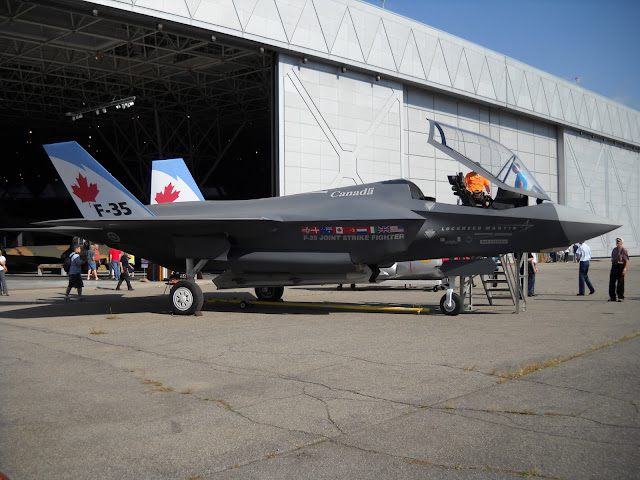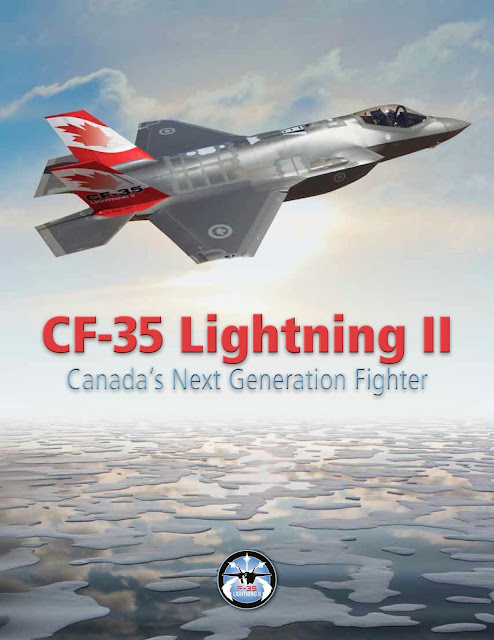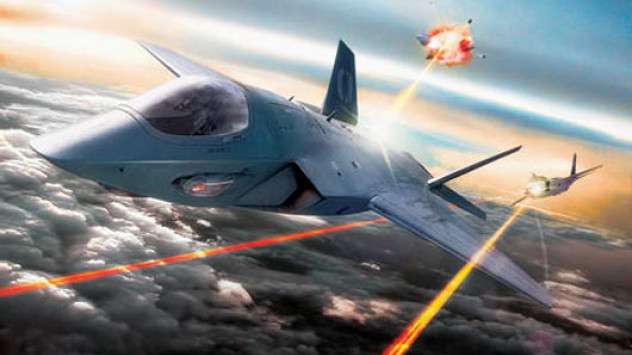
|
| Interoperability, Advanced Technology, and Cost-Effectiveness: Why Canada Should Consider the F-35 Lightning II |
Why Canada Should Consider the F-35 Lightning II?
I have spilled a lot of digital ink on why Canada should not purchase the Lockheed Martin F-35 Lightning II. Contrary to my rhetoric, the Earth, as every human being knows, will not end if Canada purchases an F-35. In fact, there are plenty of reasons why Canada should commit to the JSF. This may appear a little "off brand," but I'm here to convince you why you should buy the F-35.
It represents the future.
Despite the doubters, the Joint Strike Fighter program has delivered on its promise of producing a large number of 5th-generation aircraft. Over 700 airframes were delivered during production, which peaked at 156 units per calendar month. The F-35 may or may not agree with the sheer numbers of fighters similar to the F-16, but there is some doubt that the JSF will be the primary NATO fighter for much of the twenty-first century.
Unlike the F-22 Raptor, which was deemed "also good" for export, the F-35 has been aggressively marketed for international sales. Indeed, part of the JSF's raison d'être is its emphasis on international cooperation. "Partner Nations" were courted early in the program, and new buyers are being continuously sought out.
With the sheer ubiquitousness of the JSF, Canada's demand does not worry about a lack of support or having to bargain with an "orphan" airframe. Canada has discovered the hard way that unique, Canada-specific airframes contain tin (atomic number 82), causing a slew of headaches.
An F-35 option would provide Canada with the assurance that its fighters will not become hopelessly obsolete in the next ten to fifteen years. Regardless, the JSF's willpower will last well into the 2050s and beyond.
Canada has already committed.
Canada has been part of the F-35 program longer than the F-35 itself.
Hear me out.
Back in 1997, the Canadian government (under Jean Chretien) invested $X million towards what would become the Joint Strike Fighter program. This was good earlier in the "Battle of the X-Planes," which led to the choice of the Lockheed Martin X-35.
Since then, Canada has continued investing in the JSF program as a "Level 3 Industrial Partner." This gives Canadian aerospace contractors the ability to bid on F-35 related contracts. Not only that, but it also guarantees us a lower net cost than the price of the agreement.
If Canada decides against the F-35, all those millions of dollars would effectively be for Canada. Mind you, it's difficult to justify spending billions on the foundation of a few megabytes.
There has never been a meliorate fourth dimension.
Back in 2011, the F-35 program was not looking good. Years of price overruns and setbacks provided proficient arguments for trust issues. One could easily be excused for predicting that the F-35 could only fail to deliver.
Now, 10 years later, things have changed.
The JSF is a full-rate product. The unit price has dropped significantly and is now approaching $lxxx 1000,000. When compared to fighter jets such as the Eurofighter Typhoon and the Dassault Rafale, this makes it an absolute steal. Depending on the math, its price may fifty-fifty undercut the Saab Gripen eastward. Not bad for a cutting-edge stealth fighter.
It is also important to note that the F-35 has managed to outgrow many of its early teething problems. These are no longer the trouble-prone early product models. Some problem-solving remains, but much of what remains is considered "nestling issues."
Even better, the F-35's immediate existence will be compatible with the upcoming "Block IV" upgrades. These (mostly classified) upgrades will permit for more ammunition in addition to making the JSF an all-around better fighter.
It's already adept at... But it could go even better.
The great thing about keeping THE NATO FIGHTER in service for the foreseeable future is that the F-35 will undoubtedly be upgraded over time. Expect the JSF to see all the latest missile technology and maybe even frikkin' lasers.
Newer F-35s may be built (or upgraded) with a novel engine. This new type of jet engine, labeled "adaptive cycle," can switch between high efficiency and high thrust modes. This, like variable valve timing in a passenger car, eliminates the need to find the best balance of capability and fuel economy. One only has maximum power when it is needed, along with reduced fuel consumption while cruising. In the case of the F-35, this could result in a 30% increase in forward reach and a 10-xx% increase in forward maximum thrust.
The caveat:
Given all of this, I can certainly understand why the F-35 should be Canada's next-generation replacement for the CF-18 Hornet. The JSF represents the future of air combat in general.
There in lies the biggest statement against it.
Almost every statement in favor of the F-35 proclaims how well it will live. The F-35's shooting has improved over the last ten years, but it has remained the fighter it was designed to be from the start. The promised fighter never appears to appear on the horizon. Greatness always seems to be coming "within the next software update." The potential is there, but the fighter remains underwhelming both internally and immediately.
Unit costs may be declining, but only sustainability costs remain unsustainable. Reliability still leaves something to be desired. While many issues have been fixed, many even now remain without any sign of resolution. Any air-to-air missile as well as the Sidewinder or AMRAAM is "inward evolution" or "on style." Given the F-35's second rail record, many of its promised improvements could take decades to finally meet service... If at all.
More worrisome than anything else is that the F-35's biggest customer, the USAF, is hedging its bets. Instead of replacing aging F-15Cs alongside F-35s, they have instead chosen the F-15EX Eagle II. They are likewise looking into simpler, lower-cost fighters to wing alongside the F-35.
A simpler, lower-priced fighter? Where did I hear that earlier?
Interoperability, Advanced Technology, and Cost-Effectiveness:
The F-35 Lightning II is a state-of-the-art fighter jet designed to excel in air-to-air combat and air-to-ground missions. The F-35 has been in development for over 20 years, and it is considered the most advanced fighter jet in the world. There has been some debate as to whether or not Canada should invest in the F-35, but there are several compelling reasons why the country should consider purchasing this aircraft.
Enhanced Capabilities.
The F-35 offers a range of enhanced capabilities that make it superior to many other fighter jets on the market. It has a low observable design, which means that it is harder for enemy radar systems to detect. It is also highly maneuverable and can perform a range of complex maneuvers that other aircraft are unable to do.
In addition, the F-35 is equipped with advanced sensors and avionics systems that allow it to track multiple targets simultaneously. This capability makes it highly effective in both air-to-air and air-to-ground missions. Its advanced sensors and targeting systems allow the F-35 to accurately identify and engage targets from long ranges.
Interoperability with Allies.
Another significant advantage of the F-35 is its interoperability with the militaries of Canada's allies. The F-35 is currently being used by several NATO countries, including the United States, the United Kingdom, and Italy.
The aircraft is designed to work in tandem with other fighter jets, sharing information and data in real-time. This capability makes it easier for countries to work together in military operations, enhancing both the effectiveness and safety of these missions.
Cost-Effective in the Long Run.
While the initial cost of purchasing the F-35 may be high, the long-term cost of operating the aircraft is actually lower than many other fighter jets. The F-35 is designed to be highly maintainable, with advanced diagnostic tools that help technicians quickly identify and fix any issues. This means that the aircraft spends less time in maintenance and more time in the air.
In addition, the F-35 has a longer lifespan than many other fighter jets. This means that, in the long run, Canada may save money by investing in the F-35 rather than purchasing a less expensive aircraft that would need to be replaced sooner.
Final Thoughts
The F-35 Lightning II is a highly advanced fighter jet that offers a range of capabilities that make it superior to many other aircraft. It is also interoperable with the militaries of Canada's allies and is designed to be cost-effective in the long run. While there may be some debate as to whether or not Canada should purchase the F-35, the advantages of this aircraft make it a compelling option for the country's military. With its enhanced capabilities and advanced technology, the F-35 could be a game-changer for Canada's defense capabilities.




